


xxxxxAlfred Tennyson, one of the great English poets, is remembered above all for the musical quality of his verse, his rich imagery, and his precise mastery of language. Among his major works were The Lady of Shalott and The Lotus Eaters of 1833, the elegies contained in his In Memoriam of 1850, his famous The Charge of the Light Brigade in 1854, and his The Idylls of the King, a long series of poems based on the Arthurian legends and first published in 1859. Among his shorter poems which have stood the test of time are his Crossing the Bar, Break, Break, Break, and Flower in the Crannied Wall. A sensitive man by nature, he was deeply affected by the death of his friend Arthur Hallam in 1833, and published little over the next ten years. During this period, however, he wrote The Two Voices and In Memoriam, works in which he pondered over life and death, and explored in depth his own inner feelings about social and moral issues, and the threat posed to Christianity by the advance of science. He gained fame with his poems of 1842, which included Morte d’Arthur, and his publication of In Memoriam in 1850 led to his appointment as poet laureate. By the time he had completed his The Idylls of the King in 1885 he was a much admired literary figure, respected not only for the quality of his poetry, but also for his genuine concern for the future of mankind. He was made a peer of the realm in 1884.
ALFRED TENNYSON 1809 -
(G3c, G4, W4, Va, Vb, Vc)
Acknowledgements
Tennyson: by the English painter George Frederic Watts (1817-
 xxxxxAlfred Tennyson, one of the greatest names in English literature, gained his reputation as a poet by the splendid musical quality of his verse and his precise mastery of language. Few poets have been his equal in either of these skills. His works, many based on legend or history, included The Lady of Shalott and The Lotus Eaters of 1833, Ulysses in 1842, the elegies contained in his In Memoriam of 1850, his famous The Charge of the Light Brigade in 1854, and his The Idylls of the King, a long series of poems based on the Arthurian legends, first published in 1859. A man of compassion who became immensely popular with the public in his later years, he was appointed poet laureate in 1850 (succeeding William Wordsworth), and made a peer of the realm in 1884.
xxxxxAlfred Tennyson, one of the greatest names in English literature, gained his reputation as a poet by the splendid musical quality of his verse and his precise mastery of language. Few poets have been his equal in either of these skills. His works, many based on legend or history, included The Lady of Shalott and The Lotus Eaters of 1833, Ulysses in 1842, the elegies contained in his In Memoriam of 1850, his famous The Charge of the Light Brigade in 1854, and his The Idylls of the King, a long series of poems based on the Arthurian legends, first published in 1859. A man of compassion who became immensely popular with the public in his later years, he was appointed poet laureate in 1850 (succeeding William Wordsworth), and made a peer of the realm in 1884.
xxxxxHe was born in Somersby, Lincolnshire, the precocious son of the local Rector, and was producing verse in the style of Lord Byron, Alexander Pope and Walter Scott long before he reached his teens. He was sent with two of his brothers to Louth Grammar school in 1815 and, by all accounts, spent five unhappy years there, a fact that might well account for his sensitive nature and his tendency to suffer periods of depression. Hexwent up to Trinity College, Cambridge in 1827 where he won the chancellor’s gold medal for a poem entitled Timbuctoo, and became a close friend of Arthur Hallam (1811-
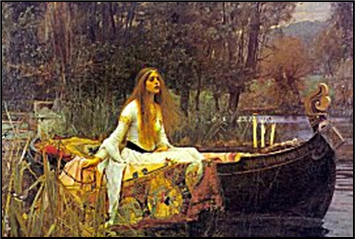 xxxxxSome of his boyhood poetry was published in his Poems by Two Brothers in 1827, and he first showed promise of his poetic talent in his Poems Chiefly Lyrical, produced in 1830. There followed his volume of poems in 1832, which included The Lady of Shalott (illustrated), the Miller’s Daughter and The Lotus Eaters, but an accompanying satirical piece on the critic Christopher North resulted in a highly unfavourable appraisal in the Quarterly Review, and this led to a somewhat muted appreciation of his works by the general public. And matters grew worse the following year with the untimely death of his friend Arthur Hallam, aged 22. This plunged Tennyson into a period of deep despair, and for the next ten years he published little, spending his time writing and in meditation. To this period belongs his The Two Voices, written in 1834, a troubled work centred around death and immortality, and a sequence of elegies which, published later under the title In Memoriam, explored in depth his own inner feelings about life and death.
xxxxxSome of his boyhood poetry was published in his Poems by Two Brothers in 1827, and he first showed promise of his poetic talent in his Poems Chiefly Lyrical, produced in 1830. There followed his volume of poems in 1832, which included The Lady of Shalott (illustrated), the Miller’s Daughter and The Lotus Eaters, but an accompanying satirical piece on the critic Christopher North resulted in a highly unfavourable appraisal in the Quarterly Review, and this led to a somewhat muted appreciation of his works by the general public. And matters grew worse the following year with the untimely death of his friend Arthur Hallam, aged 22. This plunged Tennyson into a period of deep despair, and for the next ten years he published little, spending his time writing and in meditation. To this period belongs his The Two Voices, written in 1834, a troubled work centred around death and immortality, and a sequence of elegies which, published later under the title In Memoriam, explored in depth his own inner feelings about life and death.
xxxxxIn the early 1840s Tennyson’s fortunes took a decided turn for the better. His two-
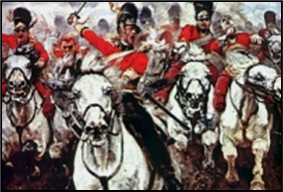 xxxxxIn 1850, the year in which he published his highly successful In Memoriam -
xxxxxIn 1850, the year in which he published his highly successful In Memoriam -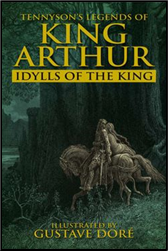 admired by Queen Victoria -
admired by Queen Victoria -
xxxxxHis later works, which included the historical dramas Queen Mary, Harold and Becket, and the moving poem Crossing the Bar, -
xxxxxTennyson married Emily Sarah Sellwood in 1850 and it proved a happy marriage. They lived for a time in Twickenham, near London, and then for some sixteen years had a house at Farringford, near Freshwater on the Isle of Wight. In 1869 they made their home at Aldworth, near Haselmere, Surrey, and it was there that he died in 1892, a much loved and respected literary figure.
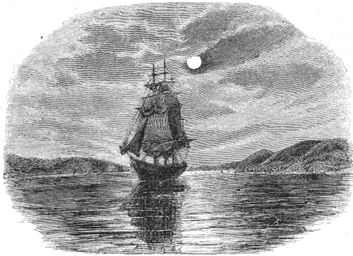 xxxxxIt must be said that, at times, Tennyson’s poetry may be seen as stilted and over-
xxxxxIt must be said that, at times, Tennyson’s poetry may be seen as stilted and over-
xxxxxGiven below are just a few of these memorable lines, together with two verses of his evocative poem Crossing the Bar, a tranquil acceptance of the approach of death.
A land
In which it seemed always afternoon.
Break, break, break,
On thy cold grey stones, O Sea!
Come into the garden, Maud,
For the black bat, night, has flown.
For men may come and men may go,
But I go on for ever.
In the Spring a young man’s fancy
Lightly turns to thoughts of love.
Kind hearts are more than coronets,
And simple faith than Norman blood.
Their’s not to reason why,
Their’s but to do and die:
Twilight and evening bell,
And after that the dark!
And may there be no sadness of farewell,
When I embark;
For though from out our bourne of Time and Place
The flood may bear me far,
I hope to see my Pilot face to face
When I have crossed the bar.
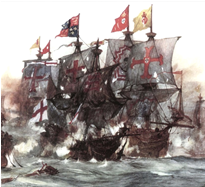
xxxxxIncidentally, Tennyson’s poem The Revenge is based on the fight that was put up by Sir Richard Grenville (1542-
xxxxx…… The Arthurian legend was a highly popular subject with the Pre-
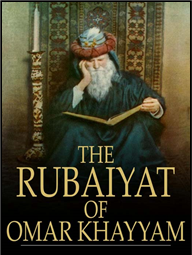
xxxxxThe English poet and translator Edward Fitzgerald (1809-
xxxxxIncidentally, FitzGerald (or “Old Fitz” as he was known) lived most of his life in Suffolk. He was buried in the churchyard of St. Michael and All Angels near his family’s former estate at Boulge. A clipping from a rose that grew on the tomb of Omar Khayyam in Nishapur, Persia (now Iran) was planted alongside his grave in 1893.
xxxxxA famous verse from the Rubaiyat reads:
The Moving Finger writes; and, having writ,
Moves on: nor all thy Piety nor Wit
Shall lure it back to cancel half a Line,
Nor all thy Tears wash out a Word of it.
Va-
Including:
Edward Fitzgerald

The Lotus Eaters
Break, Break, Break
Maud
The Brook
Locksley Hall
Lady Clara Vere de Vere
The Charge of the Light Brigade
Crossing the Bar


